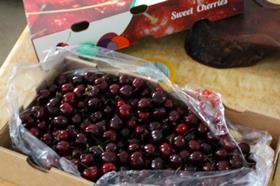
Chilean cherry exports are on course to top 100,000 tonnes for the first time ever in 2014/15, marking new milestone for the industry. However, there is uncertainty about how the Chinese market will play out in the crucial period leading up to the Lunar New Year celebrations amid mounting evidence that larger volumes are already leading to price erosion in Chile’s most important export market.
Prices in recent weeks have been some way off last year’s levels, party as a result of the bigger export crop and partly because of a delay between the peak arrival period and Chinese New Year, which this year takes place somewhat later than usual on 19 February.
According to Asoex, shipments to week 5 were running at 99,000 tonnes or 21m cartons, an increase of 45 per cent on the same period last season. Asia absorbed 82,7 per cent of this volume, almost all of it (96 per cent) going to China. The US market received 8.6 per cent of shipments, Latin America 4.7 per cent and Europe a further 3.7 per cent.
“We are very pleased with this achievement for the Chilean fruit industry, which demonstrates the great work of producers and exporters in boosting output while maintaining the highest quality and safety standards,” said Asoex president Ronald Bown.
Chilean Cherry Committee president Cristian Tagle said the larger crop and a spell of inclement weather in December had made this a challenging season for shippers.
“The heavy rainfall that affected some growing regions at the end of last year meant we had to be particularly careful to maintain the quality of shipments in order to guarantee the consistency of arrivals,” he noted.
The season has been further complicated by the arrest of the chairman of one of China’s leading fruit importers by customs authorities, reportedly for under-declaration of customs duties. Liu Zhi of Dalian Yidu was detained along with his younger brother on 16 January, just as shipments were hitting their peak in the run up to the Lunar New Year festivities.
Yidu is the biggest Chinese importer of Chilean cherries and the detention has created widespread uncertainty as to what will happen with the fruit it has in storage and consignments still on the water for which suppliers are said to be seeking alternative import clients.
According to iQonsulting, prices at Guangzhou wholesale market had fallen from a high of RMB65 per kg in week1 to RMB50 per kg in week 4. Prices for the same week in 2014 were average RMB60-70 per kg.
Tagle confirmed that the higher volume was putting pressure on the market but noted that the exchange rate favoured Chilean shippers, with the stronger US dollar making China a more attractive option than other markets.
Given the surge in production Chile has experienced in recent years, Tagle acknowledged that the biggest challenge the industry faces going forward will be placing the extra volume on the market.
Chile’s planted area has increased from 13,000ha in 2008 to 18,000ha today, a rise of 40 per cent, giving the industry a potential production volume of 150,000 tonnes –or 30m cartons – in the next four or five years.



